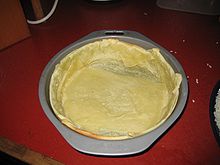Blind-baking
Baking blind (sometimes called pre-baking) is the process of baking a pie crust or other pastry without the filling. Blind baking a pie crust is necessary when it will be filled with an unbaked filling (such as with pudding or cream pies) or when the filling has a shorter bake time than the crust. Blind baking a pie crust also helps prevent the pie crust from becoming soggy from its filling. Generally, the pie crust is lined with aluminium foil or parchment paper, then filled with pastry- or pie-weights to keep the crust's shape while baking. These weights are typically ceramic or metal beads, but dried peas, lentils, beans or other pulses can be used as baking beans as well. The crust is poked repeatedly with the tines of a fork to produce small holes—this helps the steam escape and prevents the crust from bubbling up. After the pie crust is done, the temporary filling is replaced with the proper filling. Blind-baking also helps to form a nice pastry case for the filling as it has already been partially formed from blind-baking.

A pie is a baked dish which is usually made of a pastry dough casing that covers or completely contains a filling of various sweet or savoury ingredients. Pies are defined by their crusts. A filled pie (also single-crust or bottom-crust), has pastry lining the baking dish, and the filling is placed on top of the pastry, but left open. A top-crust pie, which may also be called a cobbler, has the filling in the bottom of the dish and the filling covered with a pastry or other covering before baking. A two-crust pie has the filling completely enclosed in the pastry shell. Flaky pastry is a typical kind of pastry used for pie crusts, but many things can be used, including baking powder biscuits, mashed potatoes, and crumbs. Pies can be a variety of sizes, ranging from bite-size to ones designed for multiple servings. The need for nutritious, easy-to-store, easy-to-carry, and long-lasting foods on long journeys, in particular at sea, was initially solved by taking live food along with a butcher or cook. However, this took up additional space on what were either horse-powered treks or small ships, reducing the time of travel before additional food was required. This resulted in early armies adopting the style of hunter-foraging. The introduction of the baking of processed cereals including the creation of flour, provided a more reliable source of food. Egyptian sailors carried a flat brittle bread loaf of millet bread called dhourra cake, while the Romans had a biscuit called buccellum.[1] The first pies appeared around 9500 BC, in the Egyptian Neolithic period or New Stone Age, when the use of stone tools shaped by polishing or grinding became common, the domestication of plants and animals, the establishment of permanent villages, and the practice of crafts such as pottery and weaving. Early pies were in the form of galettes wrapping honey as a treat inside a cover of ground oats, wheat, rye or barley. These galettes developed into a form of early sweet pastry or desserts, evidence of which can be found on the tomb walls of the Pharaoh Ramesses II, who ruled from 1304 to 1237 BC, located in the Valley of the Kings.[2] Sometime before 2000 BC, a recipe for chicken pie was written on a tablet in Sumer.[3] With the knowledge transferred to the Ancient Greeks, historians believe that the Greeks originated pie pastry. Then a flour-water paste (add fat, and it becomes pastry),[4] wrapped around meat, served to: cook the meat; seal in the juices; and provide a lightweight sealed holder for long sea journeys. This transferred the knowledge to the Romans who, having conquered parts of Northern Europe and southern Spain were far more adept at using salt and spices to preserve and flavour their meat.[2] The 1st century Roman cookbook Apicius make various mention of various recipes which involve a pie case.[5] By 160 BC, Roman statesman Marcus Porcius Cato (234-149 BC) who wrote De Agri Cultura, notes the recipe for the most popular pie/cake called Placenta. Also called libum by the Romans, it was more like a modern day cheesecake on a pastry base, often used as an offering to the gods. With the development of the Roman Empire and its efficient road transport, pie cooking spread throughout Europe.[2] Pies remained as a core staple of diet of traveling and working peoples in the colder northern European countries, with regional variations based on both the locally grown and available meats, as well as the locally farmed cereal crop. The Cornish pasty is an excellent adaptation of the pie to a working man's daily food needs